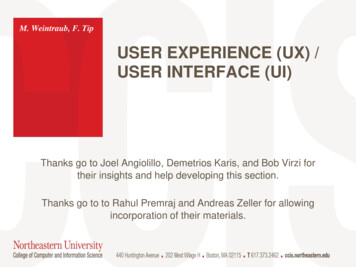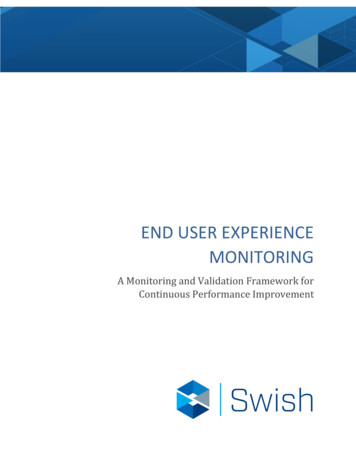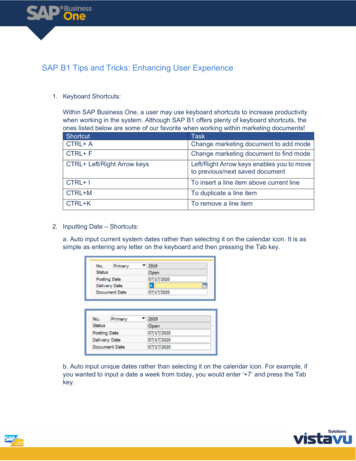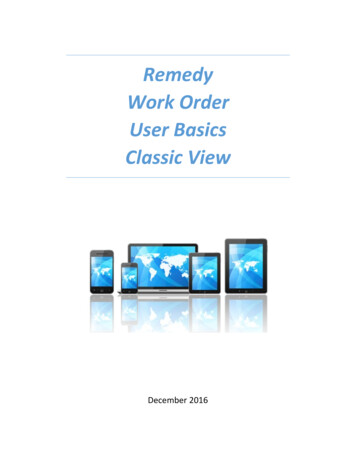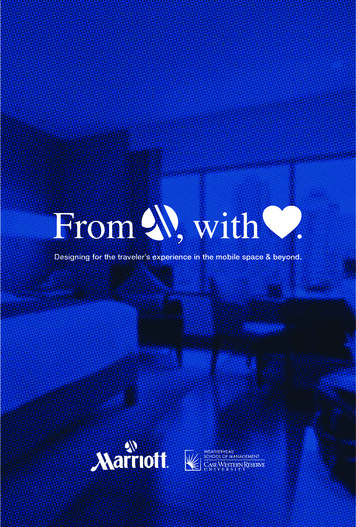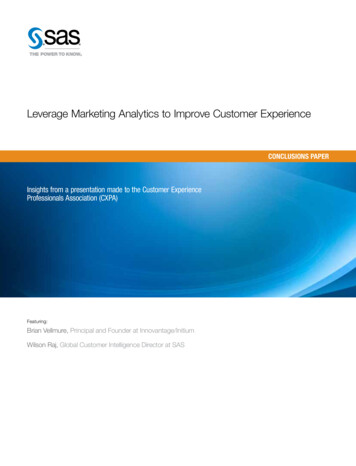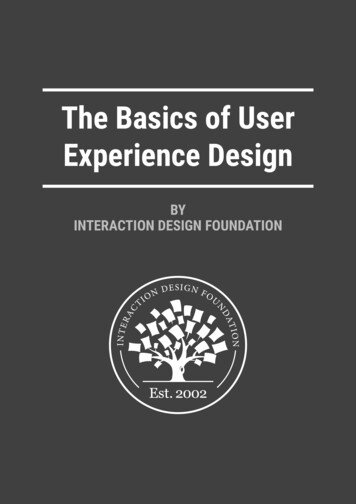
Transcription
The Basics of UserExperience DesignBYINTERACTION DESIGN FOUNDATION
The Basics of User Experience (UX) Design by Interaction Design FoundationPrefacePrefaceTo the uninitiated, UX design can seem like an intimidating field. The sheer number of topics ittouches is mind-boggling: there’s interaction design (the psychology of motion and feedback),design thinking (an iterative, empathy-based problem-solving process), and usability (how easily aproduct can be used), just to name a few. Nevertheless, that’s also what makes the field sofascinating to so many people. Whether you are a business manager working on a new product, oran aspiring designer wanting to learn about user-centered design, the field of UX design hassomething to teach you.On top of that, UX design is a booming industry worldwide. Job opportunities are increasing for UXdesigners like never before—an estimated 13% increase from 2010 to 2020. UX designer pays arealso moving up, upwards of 110k in cities such as San Francisco and New York.That’s why we, at the Interaction Design Foundation, put together this ebook. In nine highly readablechapters, we’ll cover a wide range of topics that everyone starting out in UX design should know.Each chapter acts as a mini crash course, introducing key concepts, best practices, and guidelines.At the end of each chapter, we’ll summarize the key learning points in a section called “The TakeAway”.If we’ve done a good job, each chapter should pique your interest in a specific topic under the giantumbrella of UX design. I hope you’ll enjoy this short but informative ebook, and that this will be thebeginning of a wondrous and never-ending journey of learning.Mads SoegaardFounder, Interaction Design FoundationINTERACTION-DESIGN.ORG
The Basics of User Experience (UX) Design by Interaction Design FoundationAbout the Interaction Design FoundationAbout the Interaction DesignFoundationFounded in 2002, the Interaction Design Foundation (IDF) is on a mission to provide accessible andaffordable design education to people across the world. We provide open-source educationalmaterials as well as online, self-paced UX Design courses. Through taking our courses, you'llbenefit from course materials developed by leading practitioners and academics from top-tieruniversities like Stanford University and MIT. Our course certificates will therefore help you landyour next job in design through being recognized by industry-leading corporations. We also providethe opportunity to network with fellow designers through our Local Groups initiative — withmeet-ups in 84 countries across the globe!Learn more about the Interaction Design FoundationINTERACTION-DESIGN.ORG
The Basics of User Experience (UX) Design by Interaction Design FoundationTable of ContentsTable of Contents1. A Brief Introduction to User Experience (UX) Design052. What is Design Thinking and Why Is It So Popular?103. The 7 Factors that Influence User Experience214. An Introduction to Usability285. How to Conduct User Interviews366. 7 Great, Tried and Tested UX Research Techniques437. What is Interaction Design?518. Mobile Web UX Design: Some Simple Guidelines579. Information Visualization – A Brief Introduction64INTERACTION-DESIGN.ORG
UX DESIGNCHAPTER 1A Brief Introduction to UserExperience (UX) Design3 min readUser experience (UX) design can be a complicated and overwhelming field for newcomers, as itencompasses a wide range of topics (from accessibility to wireframing). Some of these topicsoverlap, while some of them complement one another. Therefore, it's important to come to acommon and basic understanding of what the term “user experience” means in a design context.Complexity and PerceptionUser experience design, as its name suggests, is about designing the ideal experience of using aservice or product. As such, it can involve all types of products and services—think, for instance,about the design involved in a museum exhibition. However, in the main, the term user experiencedesign is used in relation to websites, web applications and other software applications.Since the second half of this century’s first decade, technologies have become increasinglycomplex, and the functionality of applications and websites has become far broader and far moreintricate. Early websites were simple static pages that served up information to feed curioussearchers; however, a few decades later, what we can find a wealth of online are sites that areinteractive and offer a much richer feel for users.INTERACTION-DESIGN.ORG5
The Basics of User Experience (UX) Design by Interaction Design Foundation1. A Brief Introduction to User Experience (UX) DesignYou can add all the features and functionality that you like to a site or application, but the successof the project rides on a single factor: how the users feel about it.“Humans have always been emotional and have always reacted to the artifacts in their worldemotionally.”—Alan Cooper, President of CooperThe questions that we as UX designers are concerned with are these: Does the site or application give the user value? Does the user find the site or application simple to use and navigate? Does the user actually enjoy using the site or the application?A UX designer can say he's or she’s doing a good job when the answer is "Yes!" to all of the above.What is User Experience (UX)?In general, user experience is simply how people feel when they use a product or service. In mostcases, that product will be a website or an application of some form. Every instance ofhuman-object interaction has an associated user experience, but, in general, UX practitioners areinterested in the relationship between human users and computers and computer-based products,such as websites, applications and systems.What is a UX Designer?A UX designer is someone who investigates and analyzes how users feel about the products he orshe offers them. UX designers then apply this knowledge to product development in order toensure that the user has the best possible experience with a product.UX designers conduct research, analyze their findings, inform other members of the developmentteam of their findings, monitor development projects to ensure those findings are implemented,and do much more.INTERACTION-DESIGN.ORG6
The Basics of User Experience (UX) Design by Interaction Design Foundation1. A Brief Introduction to User Experience (UX) DesignWhy Does UX Matter?In times gone by, product design was simple; designers built stuff they thought was cool and thatthey hoped their clients would like. Unfortunately, there are two problems with that approach. Thefirst is that, back then, there was far less competition for people's attention online. The second isthat there's no consideration for the user of the product at all in that approach—the success orfailure of a development project was down to luck as much as it was down to the judgement of thedesign team.Focusing on UX enables design to focus on the user. It increases the chances of a project'ssuccess when it finally comes to market, not least because it doesn’t gamble on the faith of usersin taking to a product just because it’s a brand name.Where Can UX Design be Found?UX Design can be found in a variety of project environments today, including: Complex projects — the more complicated the project, the more essential UX design is. Toomany features handled the wrong way can deter users like nothing else. Startups — you may not find dedicated UX teams in a startup, but UX is always part of theobjective. High-tech startups developing innovative projects need to understand how their usersfeel even more than established companies do. Projects with decent budgets — UX tends to get skipped in low-value projects, but anydevelopment project team with a decent budget will tend to allocate some of their financialresource to UX so as to ensure that the budget brings a return on investment. Long projects — the longer the project, the more resources it consumes; thus, UX becomes evermore important to delivering a return on the investment.What's the Main Methodology for UX?The main methodology used to guarantee the user experience in most projects is user-centereddesign. Simply put, user-centered design is all about designing with the users’ needs and expectedbehaviors in mind. It's important for us as UX designers to remember that user-centered design is aINTERACTION-DESIGN.ORG7
The Basics of User Experience (UX) Design by Interaction Design Foundation1. A Brief Introduction to User Experience (UX) Designmeans of achieving good UX—and not the only methodology or tool that one can use to ensureoptimal UX in a project.The Take AwayUX design is all about guiding product development to shape how users feel when using ourproducts. It's not a perfect method; sometimes, even with all the UX design know-how in the worldbehind it, a product will still fail. However, the appropriate use of UX design does offer a muchhigher chance that a product will be successful for our clients than products developed without theapplication of UX design principles.Want to avoid the common pitfalls of UX design? Our course “Become a UX Designer fromScratch” will guide you—claim your spot now!Become a UX Designer from ScratchBeginner courseUX design is a multi-faceted field that involves many topics that are interlinked—and it can feeloverwhelming for newcomers. If you’re thinking of breaking into the exciting and fulfilling field ofUX design, we’ve got you covered. In our course Become a UX Designer from Scratch, we’ll teachyou the fundamentals of UX design, what a job as a UX designer entails, how to conduct UXresearch, how to develop your CV, and many more essential skills.Learn more about this course Testimonials from Course Takers“After the last couple sessions, I know I need to rework my resume and create aUX portfolio to showcase what I've already done. My resume was more of a workhistory and didn't focus on what I've learned and what I do in UX research. Thankyou so much for that insight."Mary Ann Sprague, United StatesINTERACTION-DESIGN.ORG8
The Basics of User Experience (UX) Design by Interaction Design Foundation1. A Brief Introduction to User Experience (UX) Design“I have learnt so much through this course and in fact I thought I knew what UXwas, boy, was I mistaken, I have downloaded the three books recommended byIDF and I am reading through those. Thank you IDF I have learned so muchapplicable useful knowledge, that I know is going to further my career."Robin Davis, New ZealandView the course curriculum INTERACTION-DESIGN.ORG9
EmpathiseDefineIdeatePrototypeTestCHAPTER 2What is Design Thinking andWhy Is It So Popular?9 min readDesign thinking is not an exclusive property of designers—all great innovators in literature, art,music, science, engineering, and business have practiced it. So, why call it ‘design thinking’? What’sspecial about design thinking is that designers’ work processes can help us systematically extract,teach, learn and apply these human-centered techniques to solve problems in a creative andinnovative way — in our designs, in our businesses, in our countries, in our lives.Some of the world’s leading brands, such as Apple, Google, Samsung and GE, have rapidly adoptedthe design thinking approach. What’s more, design thinking is being taught at leading universitiesaround the world, including d.school, Stanford, Harvard and MIT. Even so, do you know what designthinking is, and why it’s so popular? Here, we’ll cut to the chase and tell you what it is and why it’sso popular.What is Design Thinking?Design thinking is an iterative process in which we seek to understand the user, challengeassumptions, and redefine problems in an attempt to identify alternative strategies and solutionsthat might not be instantly apparent with our initial level of understanding. At the same time, designthinking provides a solution-based approach to solving problems. It is a way of thinking andworking as well as a collection of hands-on methods.INTERACTION-DESIGN.ORG10
The Basics of User Experience (UX) Design by Interaction Design Foundation2. What is Design Thinking and Why Is It So Popular?Design thinking revolves around a deep interest in developing an understanding of the people forwhom we’re designing the products or services. It helps us observe and develop empathy with thetarget user. Design thinking helps us in the process of questioning: questioning the problem,questioning the assumptions, and questioning the implications. Design thinking is extremely usefulin tackling problems that are ill defined or unknown, by re-framing the problem in human-centricways, creating many ideas in brainstorming sessions, and adopting a hands-on approach inprototyping and testing. Design thinking also involves ongoing experimentation: sketching,prototyping, testing, and trying out concepts and ideas.Design Thinking’s PhasesThere are many variants of the design thinking process in use today, and they have from three toseven phases, stages, or modes. However, all variants of design thinking are very similar—they allembody the same principles, which were first described by Nobel Prize laureate Herbert Simon inThe Sciences of the Artificial in 1996. Here, we will focus on the five-phase model, which theHasso-Plattner Institute of Design at Stanford (aka ‘d.school’) proposed. We’ve chosen d.school’sapproach because they’re at the forefront of applying and teaching design thinking. The five phasesof design thinking, according to d.school, are as follows: Empathize – with your users Define – your users’ needs, their problem, and your insights Ideate – by challenging assumptions and creating ideas for innovative solutions Prototype – to start creating solutions Test – solutionsIt is important to note that the five phases, stages, or modes are not always sequential. They do nothave to follow any specific order. What’s more, they can often occur in parallel and repeatiteratively. As such, you should
UX design is a multi-faceted field that involves many topics that are interlinked—and it can feel overwhelming for newcomers. If you’re thinking of breaking into the exciting and fulfilling field of UX design, we’ve got you covered. In our course Become a UX Designer from Scratch, we’ll teach you the fundamentals of UX design, what a job as a UX designer entails, how to conduct UX .

